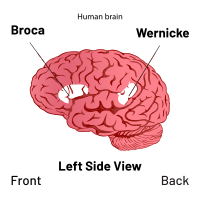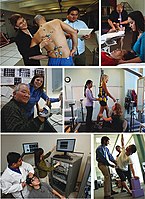
Effect of a restrictive orthosis on the paralyzed hand in combination with constraint-induced movement therapy in a patient with chronic stroke: a case report.
Sign Up to like & getrecommendations! Published in 2023 at "Disability and rehabilitation"
DOI: 10.1080/09638288.2023.2208378
Abstract: PURPOSE Many studies have reported the effects of constraint-induced movement therapy (CIMT) with an orthosis on the residual function of the impaired side of post-stroke patients. We encountered a case with left hemiparesis whose functioning… read more here.
Keywords: paralyzed hand; hand; movement therapy; constraint induced ... See more keywords

Combination of noninvasive brain stimulation and constraint-induced movement therapy in patients with stroke: a systematic review and meta-analysis
Sign Up to like & getrecommendations! Published in 2023 at "Expert Review of Neurotherapeutics"
DOI: 10.1080/14737175.2023.2177154
Abstract: ABSTRACT Introduction Constraint-induced movement therapy (CIMT) and noninvasive brain stimulation (NIBS) are used to counteract learned nonuse phenomenon and imbalance in interhemispheric inhibition following stroke. The aim of this study is to summarize the available… read more here.
Keywords: noninvasive brain; nibs cimt; movement therapy; constraint induced ... See more keywords

Predicting Improved Daily Use of the More Affected Arm Poststroke Following Constraint-Induced Movement Therapy.
Sign Up to like & getrecommendations! Published in 2019 at "Physical therapy"
DOI: 10.1093/ptj/pzz121
Abstract: BACKGROUND Constraint-induced movement therapy (CI therapy) produces, on average, large and clinically meaningful improvements in the daily use of a more affected upper extremity in individuals with hemiparesis. However, individual responses vary widely. OBJECTIVE The… read more here.
Keywords: induced movement; use; constraint induced; use affected ... See more keywords

An original pharmacoepidemiological–pharmacodynamic method: application to antipsychotic‐induced movement disorders
Sign Up to like & getrecommendations! Published in 2017 at "British Journal of Clinical Pharmacology"
DOI: 10.1111/bcp.13145
Abstract: AIMS Pharmacovigilance databases are usually used to detect new potential signals that are relevant for drug safety. They are seldom used for explanatory purposes, e.g. to understand the mechanisms of adverse drug reactions (ADRs). The… read more here.
Keywords: pharmacodynamic method; induced movement; movement; pharmacoepidemiological pharmacodynamic ... See more keywords

Occupation-based intervention versus rote exercise in modified constraint-induced movement therapy for patients with median and ulnar nerve injuries: a randomized controlled trial
Sign Up to like & getrecommendations! Published in 2017 at "Clinical Rehabilitation"
DOI: 10.1177/0269215516672276
Abstract: Objective: To investigate effect of practice type during modified constraint-induced movement therapy on hand function in patients with chronic median and ulnar nerve injuries. Design: A prospective, single-blinded, randomized controlled clinical trial. Setting: Participants’ private… read more here.
Keywords: intervention; induced movement; occupation based; constraint induced ... See more keywords

Occupational therapy home programmes for children with unilateral cerebral palsy using bimanual and modified constraint induced movement therapies: A critical review
Sign Up to like & getrecommendations! Published in 2017 at "British Journal of Occupational Therapy"
DOI: 10.1177/0308022616664738
Abstract: Introduction The home context is considered a good location for children with cerebral palsy to practise meaningful occupations. The aim of this critical review was to gain a deeper understanding of how bimanual therapy and… read more here.
Keywords: induced movement; therapy home; constraint induced; occupational therapy ... See more keywords

Phase II Randomized Controlled Trial of Constraint-Induced Movement Therapy in Multiple Sclerosis. Part 1: Effects on Real-World Function
Sign Up to like & getrecommendations! Published in 2018 at "Neurorehabilitation and Neural Repair"
DOI: 10.1177/1545968318761050
Abstract: Background. Constraint-Induced Movement therapy (CIMT) has controlled evidence of efficacy for improving real-world paretic limb use in non-progressive physically disabling disorders (stroke, cerebral palsy). Objective. This study sought to determine whether this therapy can produce… read more here.
Keywords: real world; induced movement; trial; constraint induced ... See more keywords

Clinician Perceptions of the Negative Impact of Telehealth Services in the Management of Drug-Induced Movement Disorders and Opportunities for Quality Improvement: A 2021 Internet-Based Survey
Sign Up to like & getrecommendations! Published in 2022 at "Neuropsychiatric Disease and Treatment"
DOI: 10.2147/ndt.s385960
Abstract: Purpose Tardive dyskinesia (TD) is a drug-induced movement disorder (DIMD) seen in patients taking dopamine-receptor blocking agents (DRBAs). Clinicians should regularly monitor patients with or at risk of developing DIMDs; however, telehealth visits during the… read more here.
Keywords: drug induced; dimds; telehealth services; survey ... See more keywords

Effects of constraint-induced movement therapy for the lower extremity among individuals post-stroke: A randomized controlled clinical trial.
Sign Up to like & getrecommendations! Published in 2022 at "NeuroRehabilitation"
DOI: 10.3233/nre-220139
Abstract: BACKGROUND Stroke often leads to lower extremity impairments that significantly hinders functional recovery. OBJECTIVE To investigate the effectiveness of constraint-induced movement therapy for the lower extremity (CIMT-LE) for improving balance and ambulation among people post-stroke.… read more here.
Keywords: conclusion; lower extremity; extremity; constraint induced ... See more keywords

Repeated episodes of pediatric constraint induced movement therapy with a gross motor training component: A prospective cohort study.
Sign Up to like & getrecommendations! Published in 2020 at "Journal of pediatric rehabilitation medicine"
DOI: 10.3233/prm-180543
Abstract: PURPOSE To examine the results of repeated episodes of 21-day pediatric constraint induced movement therapy (PCIMT) paired with gross motor training (GMT). METHODS Nineteen children, age 14 months - 6 years with unilateral upper extremity… read more here.
Keywords: induced movement; pediatric constraint; repeated episodes; constraint induced ... See more keywords

[Influence of constraint-induced movement therapy on childhood hemiparesis with moderate manual dexterity at 16 years of age: a systematic review].
Sign Up to like & getrecommendations! Published in 2021 at "Revista de neurologia"
DOI: 10.33588/rn.7202.2020219
Abstract: INTRODUCTION The deficit of use on the upper limb affects, as well as the quality of movement, influences the execution of a functional grasp (action of grasping-releasing an object) and therefore, reduces the possibilities of… read more here.
Keywords: induced movement; movement; constraint induced; movement therapy ... See more keywords